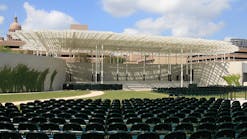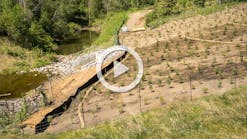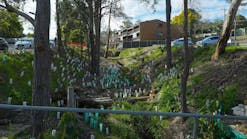The job specifications called for rolled erosion control products. But there had been lots of rain, with more forecast. The predicted weather allowed only one day for doing the job. And at the bottom of the steep slope was a creek. Any sediment that got into that creek would pollute the water supply of the downstream town.
Corey Huwa, one of the owners (with his two brothers and father) of Arnold’s Custom Seeding of Keenesburg, CO, considered his options to do this job well and safely. Access from either the top or the bottom of the slope was poor. Even if he could find enough workers to install the erosion control blankets the next day, the steepness of the slope increased the risk of workers getting hurt.
The right of way’s slope was 2 to 1 in some places and 3 to 1 in other spots. Its length was approximately 1,200 feet, and it was about 100 feet wide. The saturated soil was too unstable to support hydroseeding machines mounted on tractors. Using any type of heavy equipment would damage the slope and water bars that were needed to divert stormwater.
Revegetating the right of way over this pipeline in Pennsylvania in such a limited amount of time required hydroseeding. Huwa could see that the safest and most practical solution was to go airborne—to spray the hydroseeding mixture from the air.
“In that type of situation, nine times out of 10, we use helicopters,” he explains. He determined that two helicopters, both working at the same time, would be required to finish the job before the predicted rainfall. Huwa says that even though the helicopters would not be inexpensive, “using them would save a lot of money and time.”
Two crews worked on the project the entire day. Each crew consisted of a helicopter pilot, two people in a FINN T330 HydroSeeder, one person on the ground working with the helicopter’s basket, one water truck delivery driver, and one person to refuel the helicopter every 40 minutes.
Huwa likes FINN HydroSeeders for “their capacity, speed of mixing in general, the way the agitation process works and keeps the mixture consistent, and their reliability.”
He says that the helicopter’s spray basket doesn’t hold much. “It takes 30 loads to do one acre.”
The crew members on the HydroSeeder mixed the ingredients and sent them via hose to the person who was filling the helicopter’s aerial basket while the aircraft hovered about 30 feet above the loading area. Then the pilot flew the helicopter over to spray the mixture on the right of way.
The first spraying was of the dry ingredients. They included lime at the rate of 6 tons per acre, triple-19 fertilizer at the rate of 1,000 pounds per acre, and the seed mixture, which was native grasses with a nurse crop of rye.
The hydromulch was a flexible growth medium. It was applied by itself in a second spraying.
Huwa says his company “gets the best results when the amendments and seed are applied separately from the hydromulch. This gives the material better soil contact to increase germination and vitality and also protects the seeds from being eaten by wildlife.”
Arnold’s Custom Seeding specializes in land reclamation and stormwater mitigation. The company has 400 employees (800 seasonally) and works on projects all across the country.
For Huwa, the best part of hydroseeding work is “probably when we get to come back and see the results two years later, with the grass growing and the land not [disturbed]. Then we see the fruits of our labor.”
The Knolls
Steven Hoyt is the owner of Hoyt’s Hydroseeding in Tacoma, WA. He says that although his company is still a small one, with two crews of two men each, he is definitely in the category of a commercial hydroseeding operation, with plans to grow.
Hoyt had a C120 Epic hydroseeding machine and purchased a C330 in mid-2017. He is thinking about buying another C330. There are many features he likes about the machine, such as the stainless steel parts.
“Epic does a nice job on their machines. These guys really think things through, even little things like the swivel on the hose reel. Everything is maintenance free. It’s hard to have time for maintenance when you’re working so many hours, but you have to do it to keep the machines going,” he says.
He adds, “I like the way their remote system is set up. I can sit in the cab and run the pump, turning it off and on. It has saved me several hours of getting in and out of the truck.” The C330 has its engine in front. “Even though it is a little noisy in the cab, it [the engine placement] will save years on the machine because it stays clean,” says Hoyt. “It’s not getting dirt and fertilizer on it. My older machine with a rear-located engine is always covered in dirt and mulch.”
As for support from Epic’s customer service team, Hoyt says, “I’d give them five stars.
“There was a mechanical issue, a wiring harness problem. Jeff [Clouser] overnighted parts and really worked to find out what the problem was.”
Hoyt had been using his new Epic 330 hydroseeding machine for only about two weeks when he was interviewed for this story. He cheerfully admits, “It’s gotten me out of some pickles already.”
He appreciates how the C330 has affected his hydroseeding operation in a positive way. And that improvement translates into increased profit. “We can fit so much more mulch on the machine without having to pull a trailer. It’s a long machine. A hydroseeding machine might hold, on the average, about 80 bales of mulch on its deck. We can get 120 bales on the 330’s deck.”
He notes that his crew recently completed four jobs in one day with the machine. Each of the jobs (a golf course, two residences, and a park) was at least an hour’s driving time away from the previous project.
For actual work time, “We did [a total of] three acres in less than two and a half hours. How efficient is that?” asks Hoyt.
One of those jobs was at The Knolls, a housing development in Tacoma that covers about 40 acres. All of the sewer system at The Knolls is routed to an underground vault. This vault, which is about 300 feet by 200 feet, is three stories deep. The developer’s contractor covered the vault with dirt. Then the area was turned into a park on top, with separate areas for dogs and for children.
“It’s awesome. You would never know that the vault is below the park,” says Hoyt.
His crew hydroseeded the park, covering an area of almost 1 acre. The seed mix was 70% rye and 30% fescue. The mulch used was from Rainier, along with PAM tackifier.
Hoyt’s crew also sprayed a mycorrhizal fungus product. “I use it in all of my residential lawns. I figure it into my pricing because it gives added coverage if the homeowner doesn’t water as much as he should,” says Hoyt.
At the park, “The hose reels were set up. We used two overhead turrets and shot both of them at the same time,” explains Hoyt.
Seeding the park area at The Knolls was satisfying for Hoyt because his crews had been in on the predevelopment work there. “We did all of the pre-hydroseeding erosion control work on the project,” he says.
Reflecting on his very productive day, Hoyt says, “As many locations as we did today, I’m happy.”
Most hydroseeding company owners can probably recall an early job that was really difficult to accomplish. Hoyt’s job that seemed impossible at the time involved hydroseeding around fence lines at a US Navy base in Washington.
It was an important job, work that a purely commercial hydroseeding company would do. He was eager for the experience and the income the job would bring. Even though the work came on short notice, he thought he could get it done within a week.
“But when they said it would take three weeks, I was shivering,” he recalls. “I only had a week to spare because I had other jobs lined up afterward.”
The specifications for the job called for tackifier (PAM) on top of a bonded fiber mulch (Rainier Supreme). The land was completely flat, so both products weren’t needed. Four days later, it started raining and the military inspector called Hoyt to ask what was on the ground “looking like some kind of jellyfish.”
Then there was the extreme security required. Every morning, it took an hour and a half to have the crew and equipment inspected before they could start working. At the end of the work day, it took another hour and a half for an additional inspection before the crew could check out.
Because of security, Hoyt “never had an opportunity to put my hands on the job [before starting the work].” Somehow he and his crew got the job done, all of it by hose. He never heard from anyone in the military, but the contractor who hired him was pleased.
Looking back, he says, “Any time you’re in way over your head and come out smelling like a rose, it gives you a lot of confidence.”
Seeding at a housing development in Tacoma
Seeding a Superfund Site
Mountain West Hydroseeding of Swan Valley, ID, won the bid for hydroseeding work on an EPA Superfund project in Pocatello, ID. Hydroseeding was done on about 100 acres of the 500-acre site.
“The site was an old phosphorous processing plant owned by FMC Corporation. The company [processed and] manufactured phosphorus taken out of the mines here. In the late 1990s, they shut the plant down because of increased operating expenses,” explains Frank McClure, owner of Mountain West.
Removing old buildings and remediating the site in compliance with EPA standards for dealing with slag and contaminated soil took several years. McClure was part of the project in 2004 and 2005 when several ponds were capped.
It took several years to work out the details of reclamation for the site. When work began in 2015, the job specs called for zero dust on this project where 5 acres of soil were being moved each day.
“There was no leniency, and we had a lot of trucks going in and out. Once the soil was level, we added 1,000 pounds per acre of Conwed Fibers Hydro Mulch 1000 to control the dust. It did an exceptional job,” says McClure.
SpecTac tackifier from Rantec Corporation was also added to keep the soil in place. It was applied at the rate of 80 pounds per acre. Of the 100 acres, about 15 required the use of Flexterra. Made by Profile Products of Buffalo Grove, IL, Flexterra is a flexible growth medium.
“Originally it was spec’ed out with erosion control blankets,” says McClure. “For the size of the project and for safety, we switched over to using Flexterra. It was a great alternative to using erosion control blankets.”
He adds, “Fatigue is a part of safety [for the workers having to work in one area a long time]. The slopes were 3 to 1. They were super long, 250 to 300 feet with no breaks. Some slopes were even 400 feet long.”
Flexterra also saved on costs. “It was the equivalent to any erosion control blanket and it worked,” he says.
One seed mix was used on the entire site, and no nurse crop was used. All of the seeding on the project was done by drill seeding.
The seed mixture, a combination of native grasses and wildflowers, was supplied by Granite Seed of Lehi, UT. Wildflower seeds were Lewis flax (the plant has a beautiful blue flower and was named after the explorer Meriwether Lewis) and western yarrow. Grass seeds included western wheatgrass, thickspike wheatgrass, Indian ricegrass, sheep fescue, big bluegrass, and sand dropseed. Shrubs included four-wing saltbush and rubber rabbitbrush.
“It’s really a diverse variety of plants,” says McClure. “The grasses have a root zone ranging from one foot to three or four feet. The woodier plants have a deeper root zone. We need to have that variety of root zone to avoid sloughing off.”
Annual precipitation in the Pocatello area is about 11 inches. McClure says the native grasses will adapt to the moisture level in the soil.
The weather was also a challenge on this project. “We had record snowfalls and record rainfalls in October and November of 2016,” he recalls. “All of the elements were against us.”
Three feet of snow fell in the area from December through February. Then the snow melted quickly in February, causing flooding in eastern Idaho. Even so, McClure says the Flexterra performed well. “We were about 80% successful [with the first seeding]. Fifteen percent of the slopes failed, but we still saved money.”
Going back to those areas where grass didn’t grow, he says, “We fixed the dirt. Then we reseeded and re-Flexterra’d in the spring of 2017.”
McClure says he was surprised at “how well the Flexterra literally held the soil together at the surface. The erosion took place below the surface. The Flexterra was like a bridge at the surface, but the moisture was so great that it took soil away below the surface.”
He adds, “There were no organics in the soil, no structure to it. It was basically volcanic ash, very fine. With that kind of soil, any rainfall shut us down for a day or two.”
A crew of seven to eight members worked on the project during 2016. In 2017, that number had gone down to five, with less work to do.
McClure uses a FINN T170 HydroSeeder mounted on a truck. For this project, he purchased another FINN HydroSeeder. The new machine is a T330 and is mounted on track-style treads.
“The soil had been tested earlier for compaction. It was very sensitive, so we could not put trucks on the soil,” explains McClure, who has made good use of his T330 on other projects where a track-style machine is best suited. “We’re dealing with a lot of projects where the environmental footprint is important,” he says.
He notes that he was surprised “at the diversity of the project, with several different applications going on at the same time, and the mass scale of the different applications we had to implement.”
Wildlife on the project site included a moose, many deer, and—less welcome—rattlesnakes. The snakes, looking for mice, burrowed into straw bales stacked on the site waiting to be used for dry mulch.
The work site had no major electrical substations, but crew members had to be aware of the high-voltage power lines. McClure says they also had to “be aware of our spray patterns, to not spray across a power line or touch a tower leg.”
Seeding the Sound
Country Green Turf Farms operates sod farms in western Washington, growing sod for residential and commercial uses. The company’s hydroseeding operation is run from its location in Olympia.
One of Country Green’s hydroseeding projects in the summer of 2017 was on the land surrounding the Pierce County (Washington) Wastewater Treatment Plant. The plant is near the town of University Place.
“We started at the end of June. From then to September we made six or seven trips to work on the site,” says Jason Welsh, hydroseed and contractor services manager for Country Green Turf Farms.
The area that was hydroseeded totaled about 10 acres. The work was done in several sessions after the general contractor had graded each smaller section of the land.
The site was formerly a rock quarry. Most of the property contains the Chambers Bay golf course, the location of the 2016 US Open Golf Tournament.
“The site borders Puget Sound, with only a railroad between. It has a beautiful view,” says Welsh.
The seed mix used came from Sunmark Seeds of Portland, OR. It included five grasses: meadow barley, California brome, red fescue, tufted hairgrass, and spike bentgrass. No nurse crop was sown on the unirrigated site because there was no need to speed growth.
“Sunmark has seeds native to the Pacific Northwest, so we get seeds from them often. We used a native erosion control mix on this project,” says Welsh.
The soil on the site was “a mixture of sand, gravel, and stone. It was very porous,” he recalls. To improve the rate of germination and growth of the seeds, Verdyol Biotic Earth was first added to the site. Only the product and water were sprayed on the site, using the turret or tower of the machine. The rate was 4,000 pounds per acre. The Biotic Earth soaked right into the soil. “It didn’t create much of a larger surface—three or four inches—like mulch does,” explains Welsh.
“Two days later, we sprayed the seed mix with water, fertilizer, and Flexterra on the first section of the work area,” he adds.
Sunmark Seeds recommends that one pound of the seed mix used for the project covers 1,000 square feet. The Flexterra was sprayed at the rate of 3,500 pounds per acre.
The crew consisted of four men, two on each Bowie hydroseeding machine. Water was available on the site.
“We have one Bowie Hydro-Mulcher Imperial 3000 and two 1500 models. We just got another 3000 model,” says Welsh. “They’re both great machines.”
He notes, “With the larger model, we’re loading less often, and that equates with increased production time.”
The hillsides at the back of the property have 2-to-1 slopes. A few places are 3-to-1. Weather was a significant factor for this project, causing some work to be postponed.
“We had earlier and heavier rain in the fall. The rain didn’t stop falling for seven months. The site had significant gullies and washouts. The contractor spent the spring of 2017 restoring the site,” says Welsh.
Wildlife posed no problems, and access to the work site was good. “It was easy to drive in and out. We had full access above and below the slopes,” he adds.
Making the earth green again is done in a great variety of situations. The common factor in these four projects is the skilled use of the best hydroseeding techniques and products for each particular site.







